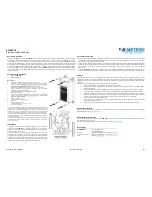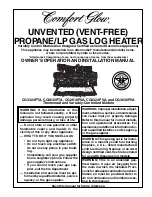
PAGE 2 of 61 HO-7-1237 & HO-4-1234 OIL-FIRED HEATERS
© SAMUEL JACKSON, INCORPORATED 2003 ALL RIGHTS RESERVED
SAFETY FEATURES
OF
SAMUEL JACKSON OIL-FIRED HEATERS
Many of the traditional safety features designed into drying heaters can be tampered with
and circumvented if the operating personnel are desperate to maintain production. An
important, but hidden, safety feature in all Samuel Jackson heaters is their dependable
performance. Each heater is completely assembled in the factory and tested before
shipment. Depending upon your location, a factory representative may perform startup
of the heater in the field to insure trouble-free performance and customer satisfaction.
Safety features which are not ordinarily used on drying heaters for the cotton industry
are outlined below:
♦
A static pressure switch is often used on older heaters to infer that air is moving
through the dryer. If a chokeup occurs, static pressure is still present and the burner
continues to operate. This can cause a fire. All Samuel Jackson heaters use an air
flow switch which measures the difference in pressure sensed by orifices pointing
upstream and downstream. In order to give immediate burner shutoff, and serve as a
safety backup for the air flow switch, we include a fan interlock device for each
burner.
♦
The combustion control system performs six air flow tests and interlocks, including
tests for a jammed or jumpered air flow switch, presence of electrical fan interlocks,
and warnings of impending chokages in the air stream.
♦
To prevent any debris from jamming a gas valve in the open position or causing it to
leak when closed, we use two internationally approved gas shutoff valves in series.
The burner’s PLC control system checks these valves for leaks following each
shutdown of the burner. If the valves fail a test, an alphanumeric display notifies the
operator, at both the console and burner cabinet, of the problem and more
specifically, where to look for the suspect valve. If the valves pass the test, an
alternate test is used following the next shutdown. This routine is repeated for the life
of the heater. The combustion control computer checks for other safety and
performance problems and notifies the operator with clear alphanumeric descriptions.
The PLC maintains an error history with the time and date that each problem
occurred. (DUAL-FUEL ONLY)
♦
When the burner flame goes out during operation on older heaters, it is customary for
the flame safeguard relay to fire the sparkplug immediately in an attempt to reignite.
If air flow has been choked enough to produce an explosive mixture, this can be
serious. If our burner should flameout, it will first close all fuel valves, then wait for
air to purge the drying system. It then proceeds to restart the burner, observing all
safety precautions, including checking for flame relay problems.






































